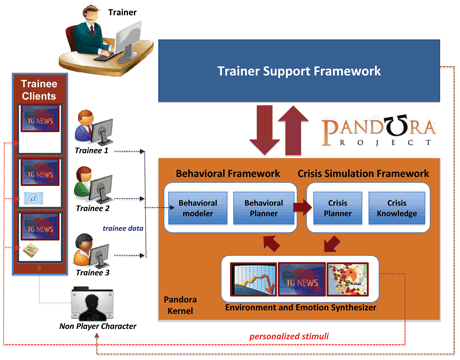The goal of PANDORA is to apply state-of-the-art ICT technologies to build a learning environment for strategic crisis managers. We are currently refining a first version where training sessions are animated by reproducing realistic crisis events and fostering creative decision-making. Central to PANDORA is an original use of the timeline-based planning strategies used to diversify crisis scenarios by creating alternative training paths and to model trainees behavioral patterns for personalized training.
Crisis management in emergency situations helps significantly to avoid major losses and may prevent emergencies from becoming disasters. The success of crisis management depends heavily on the effectiveness of high-level strategic choices and the reasoning abilities of decision makers.
Three different levels of decision makers exist in current approaches to crisis management:
- operational level or bronze commanders, directly operating on crisis scenarios, whose actions and results are monitored and communicated to higher levels
- tactical level or silver commanders, responsible for translating high-level strategic decisions into actions and related resources allocations
- strategic level or gold commanders, who identify key issues and decide strategies to resolve the crisis.
The PANDORA project aims at creating an advanced training environment for crisis decision makers who operate in highly stressful situations. They must react effectively and coordinate interventions with different authorities to limit the dangerous effects of crises and to enable quick recoveries. Contrary to almost all the state-of-the-art training systems, aimed at the operational or tactical level, PANDORA targets decision-making at the strategic level, which presents interesting open challenges.
There are two main approaches to training: (a) tabletop exercises (group discussions guided by a simulated disaster); (b) real world simulation exercises (field-tests replicating emergency situations). Tabletop exercises are low cost and easy to organise, but they cannot recreate the real atmosphere, in terms of stress and pressure. On the other hand, real world simulations can be very effective but are extremely expensive and difficult to organize.
PANDORA aims at replicating the benefits of both training approaches by developing a system capable of guaranteeing the realism of the real world simulation and the practicality of tabletop exercises. A user-centered approach is followed and we have worked in close collaboration with the UK Emergency Planning College, which has identified the main requirements, and is influencing the design and implementation decisions.
Figure 1 summarizes the main concept of PANDORA. A group of trainees, from different agencies (eg, Civil Defence, Health, Fire Service, Police, Transportation) access the training system. If some authorities are not present, they are simulated through Non Player Characters. Each trainee feeds personal data to the PANDORA kernel, which gathers this information to build a user model (Behavioral Module). On the basis of this model, the system synthesizes personalized training paths (Behavioral Planner). The output of this process is passed to a second module (Crisis Planner), which uses both the Behavioral Module indications and knowledge of the chosen scenario to plan sequences of stimuli appropriate for the group (information shared among all trainees) and the individual trainees (information tailored to induce the “right level of stress”).

Figure 1: The PANDORA system architecture.
The plan is then passed to the Environment and Emotion Synthesizer, responsible for an effective rendering of the various stimuli. A separate module (Trainer Support Framework) allows trainers to control the training session and dynamically adjust the stimuli based on their experience.
PANDORA uses timeline-based planning technology which allows for rich domain modelling and uses both temporal and resource constraints. A timeline can be seen as a stepwise constant function of time. Specifically it is an ordered sequence of values holding on subsequent temporal intervals. This approach has been used both in the Behavioural and the Crisis Framework.
In the first case some psycho-physiological trainee features, shown to influence human behaviour under crisis, are modelled and updated during training as timelines. On the basis of this model, the Behavioural Planner synthesizes goals for the Crisis Planner. The Crisis Planner creates training storyboards, sets of “events” communicated to the trainees (eg, a news video from the crisis setting, a phone call or e-mail from an operational or tactical manager). Additionally, the Planner “reacts” to trainees’ strategic decisions, triggering subequent events to continue the session.
The overall system empowers the trainer with a new means for training people. Indeed the suggested crisis stimuli and the behavioural analysis are presented to the trainer to influence at any moment the training session, in perfect line with a mixed-initiative style.
Links:
http://www.pandoraproject.eu/
http://epcollege.com/
http://pst.istc.cnr.it/
Please contact:
Amedeo Cesta, ISTC-CNR, Italy
E-mail:
Keith Strickland, EPC, UK









